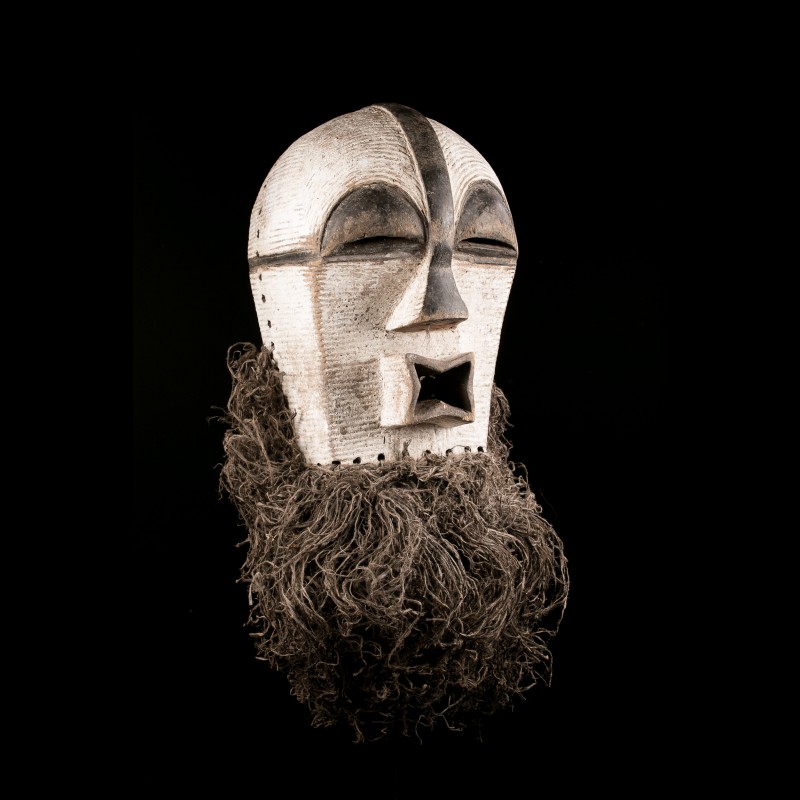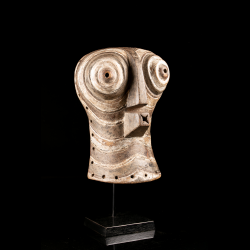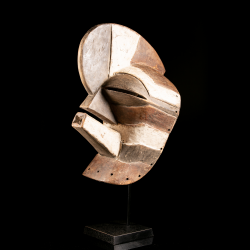











Superb old African mask of Songye origin in the south of the R. D. Congo.
Traditional female masks called bifwebe mukashi are much rarer than male ones.
Entirely painted in white and devoid of a sagittal crest, they are decorated with a black band which separates the two lobes of the skull and extends to the nose, while the eyebrows and the mouth are generally outlined in black or red. Linked to the moon, fertility and the process of procreation, their peaceful demeanor contrasts with the aggressiveness of their male companions.
The term tunsadi (“the three fingers of the mask”) is part of the vocabulary specifically designed to describe the different parts of the kifwebe mask, a hermetic corpus that any new initiate must learn by heart.
Thus the right side of the face symbolizes the sun, the left side the moon, the eye slit is identified with the entrance of a termite mound, the mouth with a bird's beak and the chin with the jaw of a crocodile.
The ridges are those of the zebra or antelope Tragelaphus scriptus, and the plume extending above the top of the skull is its fiber-lined "horn" topped with feathers containing its protective charms.
Finally, the sagittal crest of male masks symbolizes that of the rooster.
It is difficult to determine when these first kifwebe masks were created. But the powerful style characteristic of this type of mask and its various variations certainly took time to develop, and its roots must go back well beyond the dawn of the 20th century.
Around the 1950s, Songye artists, aware that "cubist" expressionist forms appealed to Europeans, further accentuated the salient features of their works, thus creating a more commercial substyle. But that takes nothing away from the genius of certain Lomami River sculptors.
It is said that the first kifwebe mask arrived in Europe in 1885.
The Songye continue to maintain their rich and diverse cultural heritage.
Today, their masks and their statues (mankishi, fetish figures) are very popular all over the world and are exhibited in many international museums.
Piece from a family of Belgian entrepreneurs in the Democratic Republic of Congo. Stand included.
Data sheet
You might also like

Superb old African mask of Songye origin in the south of the R. D. Congo.
Traditional female masks called bifwebe mukashi are much rarer than male ones.
Entirely painted in white and devoid of a sagittal crest, they are decorated with a black band which separates the two lobes of the skull and extends to the nose, while the eyebrows and the mouth are generally outlined in black or red. Linked to the moon, fertility and the process of procreation, their peaceful demeanor contrasts with the aggressiveness of their male companions.
The term tunsadi (“the three fingers of the mask”) is part of the vocabulary specifically designed to describe the different parts of the kifwebe mask, a hermetic corpus that any new initiate must learn by heart.
Thus the right side of the face symbolizes the sun, the left side the moon, the eye slit is identified with the entrance of a termite mound, the mouth with a bird's beak and the chin with the jaw of a crocodile.
The ridges are those of the zebra or antelope Tragelaphus scriptus, and the plume extending above the top of the skull is its fiber-lined "horn" topped with feathers containing its protective charms.
Finally, the sagittal crest of male masks symbolizes that of the rooster.
It is difficult to determine when these first kifwebe masks were created. But the powerful style characteristic of this type of mask and its various variations certainly took time to develop, and its roots must go back well beyond the dawn of the 20th century.
Around the 1950s, Songye artists, aware that "cubist" expressionist forms appealed to Europeans, further accentuated the salient features of their works, thus creating a more commercial substyle. But that takes nothing away from the genius of certain Lomami River sculptors.
It is said that the first kifwebe mask arrived in Europe in 1885.
The Songye continue to maintain their rich and diverse cultural heritage.
Today, their masks and their statues (mankishi, fetish figures) are very popular all over the world and are exhibited in many international museums.
Piece from a family of Belgian entrepreneurs in the Democratic Republic of Congo. Stand included.


